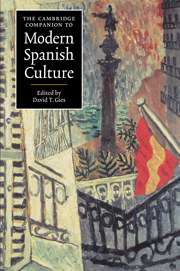Book contents
- Frontmatter
- Modern Spanish culture
- I Culture
- II Culture and history
- III Culture and prose
- IV Culture and poetry
- V Culture and theater
- VI Culture and the arts
- 17 Painting and sculpture in modern Spain
- 18 Culture and cinema to 1975
- 19 Culture and cinema, 1975-1996
- 20 A century of Spanish architecture
- 21 Spanish music and cultural identity
- 22 To live is to dance
- VII Media
- Index
- Series List
19 - Culture and cinema, 1975-1996
from VI - Culture and the arts
Published online by Cambridge University Press: 28 May 2006
- Frontmatter
- Modern Spanish culture
- I Culture
- II Culture and history
- III Culture and prose
- IV Culture and poetry
- V Culture and theater
- VI Culture and the arts
- 17 Painting and sculpture in modern Spain
- 18 Culture and cinema to 1975
- 19 Culture and cinema, 1975-1996
- 20 A century of Spanish architecture
- 21 Spanish music and cultural identity
- 22 To live is to dance
- VII Media
- Index
- Series List
Summary
Arguably the single most important event in the history of cinema in Spain after 1975 was the official abolition of censorship in 1977, thus bringing to an end a system that allowed the state censor to cut or destroy a film during shooting and at pre- and post-shooting stages. The prime movers behind Franco's censors were the Catholic church. With the secularization of the state under the new constitution, the church's fading influence over the population as a whole (by 1991 only 49 percent of the population considered themselves practicing Catholics) was quickly reflected in the cinema's eager neglect of all the old taboos. Since 1975 the church itself has forfeited the kind of reverential treatment which it had enjoyed under the ancien régime in pious films like Marcelino pan y vino (Marcelino Bread and Wine, Vajda, 1954) or Balarassa (Nieves Conde, 1950). Films like Padre nuestro (Our Father, Regueiro, 1985) took a more jaundiced view - almost approaching in tone the satirical treatment of the clergy in nineteenth-century novels like La Regenta (The Regent's Wife) - of the working lives of Spanish priests.
- Type
- Chapter
- Information
- The Cambridge Companion to Modern Spanish Culture , pp. 267 - 277Publisher: Cambridge University PressPrint publication year: 1999
- 3
- Cited by



